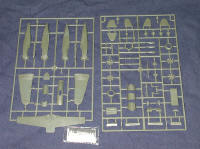
|
KIT: |
AML 1/72 Fiat G.50 bis |
|
KIT # |
72-021 |
|
PRICE: |
$24.98 (22.46 at Squadron) |
|
DECALS: |
Four options |
|
REVIEWER: |
Scott Van Aken |
|
NOTES: |
Short run with resin, etched metal and vacuformed parts. |

|
HISTORY |
The G.50 and G.50 bis were used until 1944 in various places like Greece, North Africa, the Balkans and other areas around the Mediterranean. 12 of the initial series of aircraft were sent to Spain during the Spanish Civil War, but did not reach the area until the war was nearly over so were not really battle tested. Aircraft were also sent to Finland and Croatia, while some were used by the Luftwaffe as fighter trainers after the Italian surrender in 1943.
|
THE KIT |
 AML
has done quite a few aircraft kits and generally tends to stick with
single-engine fighters. Like previous efforts, this one is also a short
run kit, about at the level of detail that MPM kits were in the early
years. The first thing I noticed is that there are two fuselages. That is
so one can do a regular G.50 or a G.50 bis. My untrained eye sees little
difference between the two. Overall detail is engraved, and rather
lightly so with the plastic itself a bit rough in a few places.
AML
has done quite a few aircraft kits and generally tends to stick with
single-engine fighters. Like previous efforts, this one is also a short
run kit, about at the level of detail that MPM kits were in the early
years. The first thing I noticed is that there are two fuselages. That is
so one can do a regular G.50 or a G.50 bis. My untrained eye sees little
difference between the two. Overall detail is engraved, and rather
lightly so with the plastic itself a bit rough in a few places.
There is detail on the inside of the fuselage halves and there are separate flaps and ailerons should you decide to go that route. One also gets two different fins depending on which version you are building. The engine is rather generic so you may wish to find a replacement version. Photoetch and resin are mostly used in the interior and for some things like gun barrels, aileron balances and other small bits. The kit continues the trend of offering separate prop blades and hub, though in this case, you are provided two different spinners to hide the prop attachment points. The kit is free from any real flash and there are no sink marks. The major bits do have ejector towers that you'll have to remove. One other thing that I notices is that the framework of the control surfaces is rather pronounced. Some like it and some don't . There are two vacuformed canopies. To be honest, you aren't going to see much of the interior as the opening is so small, though you may want to cut open one or both of the entrance doors. Though the instructions don't tell you what parts are not used, it seems to me that there will be quite a few of them!
 Instructions
are well done with ten construction steps and a few inserts showing some
detail of parts placement. The camo and decal section is very well done
and in full color. There is a painting guide with FS, Humbrol, Life Color
and Agma references, where they are applicable. Markings are provided for
four aircraft. One is a Croatian aircraft in Dark Olive Green over Light
Blue Grey. It carries Eastern Front markings in the form of a yellow
fuselage band and lower wing tips. In the same camo but without the
yellow is a fighter trainer of 3./JG 108 in 1944. The other two are in
Camo Yellow with mottles of Camo Brown and Camo Green over Camo Grey.
First is from 395 Squadriglia, 154 Gruppo in Albania during March 1941.
This one has a yellow cowling and white fuselage band as shown on the box
art. The other is from 355a Squadriglia, 24 Greppo, also in Albania, but
with out the yellow. It was flown by Cap. Ettore Foschini, an ace with 7
kills from Greece, Spain and Russia. Decals are very thin and superbly
printed.
Instructions
are well done with ten construction steps and a few inserts showing some
detail of parts placement. The camo and decal section is very well done
and in full color. There is a painting guide with FS, Humbrol, Life Color
and Agma references, where they are applicable. Markings are provided for
four aircraft. One is a Croatian aircraft in Dark Olive Green over Light
Blue Grey. It carries Eastern Front markings in the form of a yellow
fuselage band and lower wing tips. In the same camo but without the
yellow is a fighter trainer of 3./JG 108 in 1944. The other two are in
Camo Yellow with mottles of Camo Brown and Camo Green over Camo Grey.
First is from 395 Squadriglia, 154 Gruppo in Albania during March 1941.
This one has a yellow cowling and white fuselage band as shown on the box
art. The other is from 355a Squadriglia, 24 Greppo, also in Albania, but
with out the yellow. It was flown by Cap. Ettore Foschini, an ace with 7
kills from Greece, Spain and Russia. Decals are very thin and superbly
printed.
|
CONCLUSIONS |
Though it will be a bit of a challenge to build, as are all short run kits, it is a huge improvement over the very old and rather inaccurate Airfix kit. If your tastes are 1/72 Italian planes, then you really should consider this one.
You can find this kit and many others at

If you would like your product reviewed fairly and quickly by a site that has over 250,000 visitors a month, please contact me or see other details in the Note to Contributors.